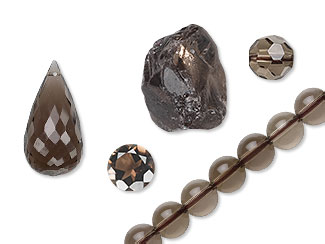

History
Alluring smoky quartz (also known as smoky topaz*), named for its smoky color, is formed when rock crystal is naturally irradiated. (Its frequent inclusions of rutile needles, by the way, do not affect its quality.) Smoky quartz ranges in color from light grayish-brown to deep black. It is most typically transparent to translucent but can be opaque. Flat planes of smoky quartz were used by the Chinese in the 12th century for sunglasses. A variety of smoky quartz called cairngorm, found in the Cairngorm Mountains of Scotland, is used in Scottish jewelry and as a decoration on kilt pins. Smoky Quartz is used in a variety of jewelry, especially ring and pendant centerpieces. Lesser quality stones, usually with a lighter color, are used as beads or cabochons.
*According to Walter Schumann’s Gemstone of the World (3rd edition, p. 132), the name smoky topaz is improper and no longer acceptable in the trade.
Metaphysical Properties
Smoky quartz is prized for its perceived ability to ward off stress while promoting tolerance and resolve in difficult situations. It is thought to be a protective stone, with a strong association with the earth and base chakras, making it ideal for environmental consciousness. Smoky quartz is also believed to counter fear, overcome depression and bring about emotional stability while facilitating positive, practical thinking with clear insights.

Comments are closed.